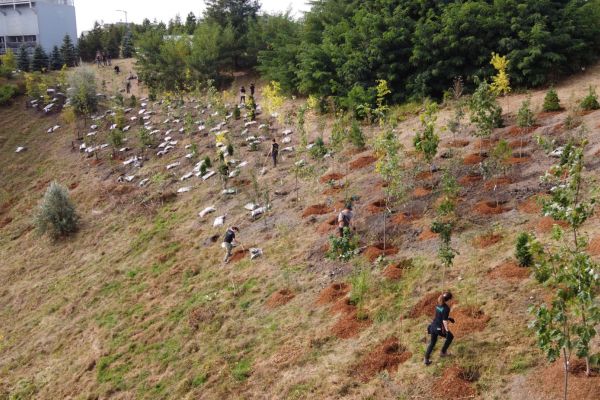Tree planting flourishes at the MUHC
The urban tree canopy at the MUHC, and in the city’s west end, just got a lot denser—thanks to an ambitious project in which hundreds of new trees have been planted at the Glen site.

Red marks the spot
Preparations for the planting extravaganza began September 26th under sunny skies and mild temperatures. More than a dozen Soverdi tree specialists descended on the grassy slope between Chemin Glen and St. Jacques ready for a busy week of transplanting. Red dots mapped out locations for the saplings, and tree planting machines effortlessly dug holes. “We planted 400 small to medium-sized trees. The LEED certification at the MUHC requires species indigenous to Quebec and Canada such as oak, maple, and pine. We made sure to plant trees that measured 30 millimetres in diameter and a height of two metres, since trees this size have the greatest chance of surviving their first winter,” said project manager Marie-Louise Bédard.

Ripple effect of spring planting
The project follows last spring’s popular tree planting activity to celebrate the MUHC’s 25th anniversary. “When we were here in the spring to help plant 45 trees, we saw the potential. I was very excited. I told the organizers that I would love to return in the fall and contribute to the greening of the community,” said Marie-Louise. The tree specialists’ primary interest was the area east of employee parking. “The embankment there tends to erode. Since it is next to the Turcot interchange there is a lot of dust and noise pollution,” she explained.

The right tree in the right spot
Invasive trees, shrubs and grasses inhabit the steep embankment. Properly selected native trees will help prevent them from taking hold. “The trees will add another layer to the biodiversity and the root system will help stabilize the slope,” said Marie-Louise. The trees will also help reduce soil loss and water run-off from strong rains like the ones we experienced this summer.

A tree expert’s work is never done
Grants from the City of Montreal, Environment and Natural Resources Canada, Soverdi and AtkinsRéalis (formerly SNC Lavalin) financed the $87,500 project, which includes maintenance for the next two years. “Depending on the weather, we will water once a week and protect against rodents,” said Marie-Louise, who also took the opportunity to check on the health of the trees planted in the spring. “I don’t think we lost any of those trees,” she announced proudly.

Being on the site regularly gives Soverdi an excuse to scope out other zones that could benefit from a tree-planting campaign. “There is still room,” she admitted. “Each plantation has its own advantages and objectives. Planting even just a few trees near a parking lot or train tracks can make a big difference in heat islands.” Urban areas, where infrastructure is highly concentrated and greenery is limited, tend to trap heat and amplify the higher temperatures. Technical Services will work alongside Soverdi to determine the potential for tree planting on other MUHC sites.

While the weather is still warm, take a short walk to check out the tremendous effort to enhance the urban environment. Over the coming years, you’ll be able to watch these trees mature.

Enjoy the photo gallery and videos.
Photo credits Soverdi, Denis Bastien, MUHC Communications
Picture Gallery








